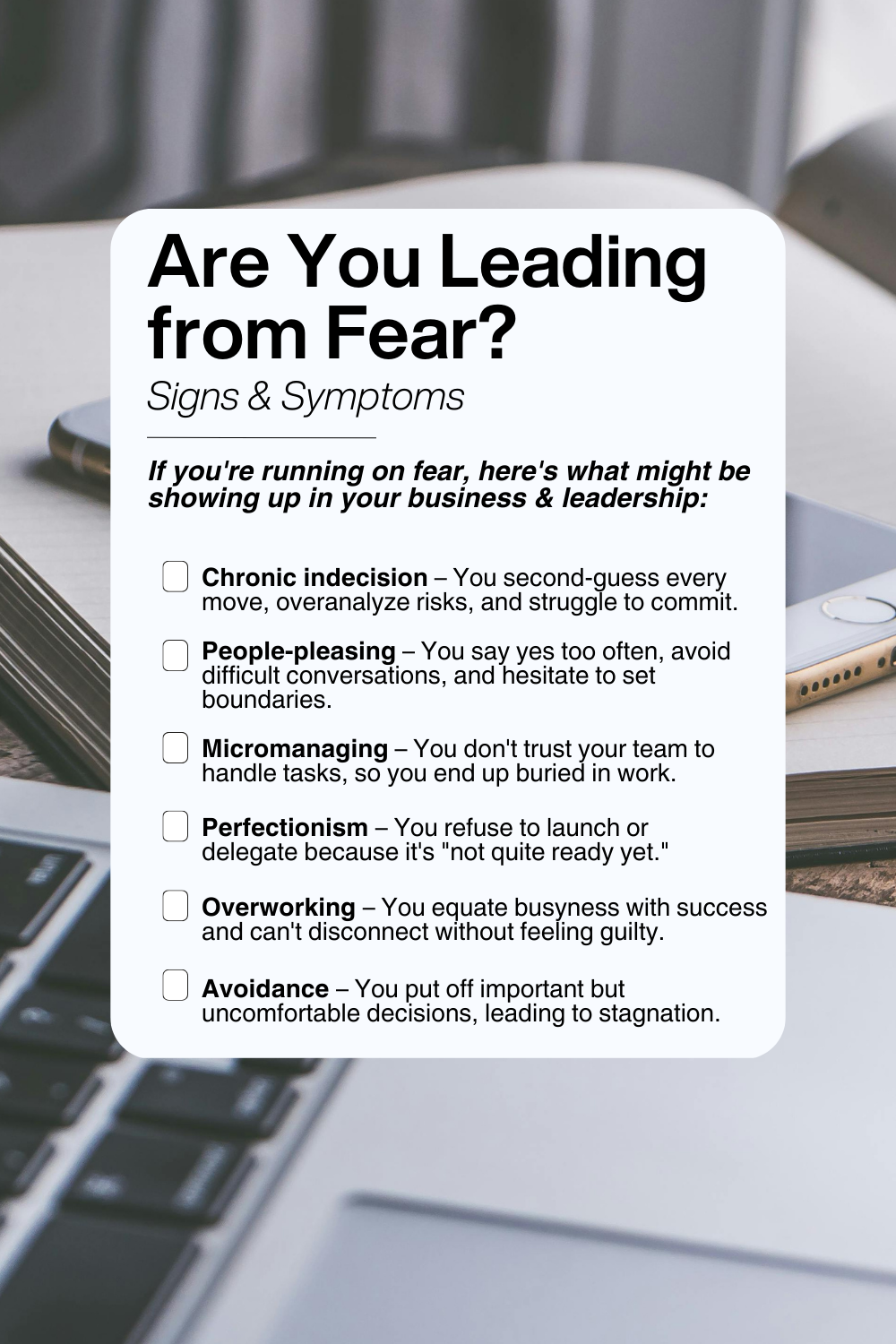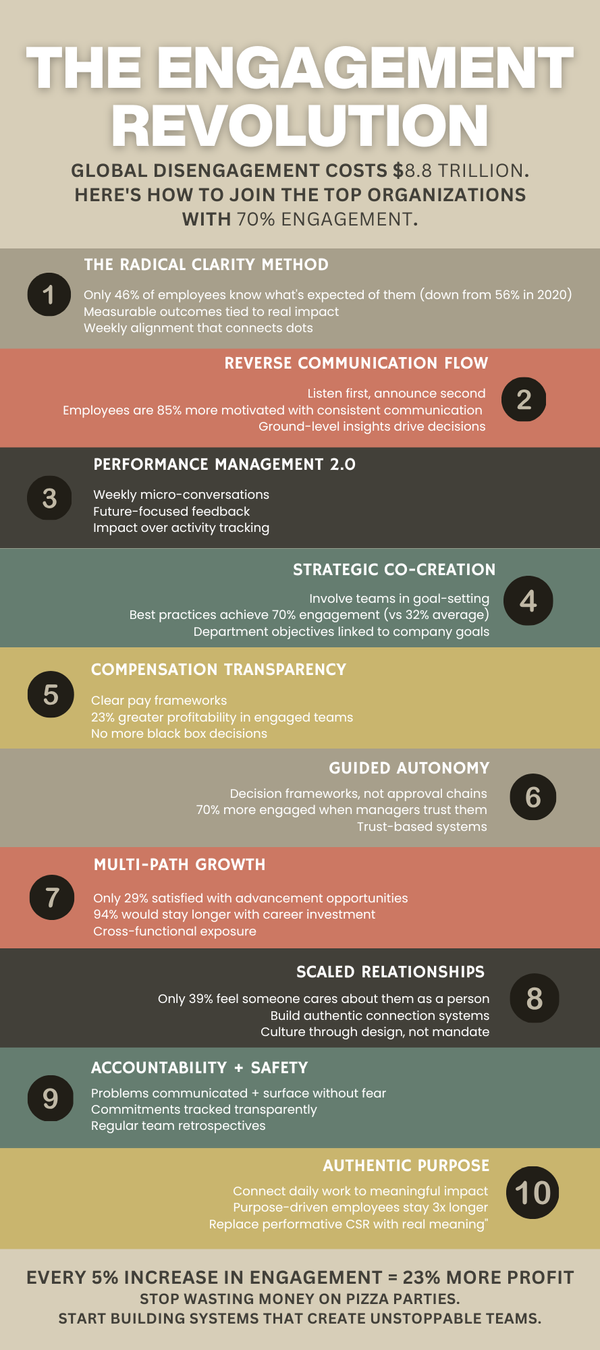I watched a brilliant founder crumble when she realized her "high standards" were actually fear in disguise. Her team was disengaged, her growth had plateaued, and she couldn't figure out why.
Subheading: The Silent Saboteur isn't burnout or market conditions—it's fear.
Fear isn't just an emotion—it's a powerful force that dictates decision-making, limits opportunities, stifles creativity, and keeps you from scaling and growing. When you lead from a place of fear, your brain shifts into survival mode, prioritizing short-term safety over long-term strategy.
The problem?
You might not even recognize it's happening. Fear disguises itself as overworking, perfectionism, hesitation, or even people-pleasing.
It's costing you money, time, and energy.
Are You Leading from Fear? Signs & Symptoms
If you're running on fear, here's what might be showing up in your business and leadership style:
Chronic indecision – You second-guess every move, overanalyze risks, and struggle to commit.
People-pleasing – You say yes too often, avoid difficult conversations, and hesitate to set boundaries.
Micromanaging – You don't trust your team to handle tasks, so you end up buried in work.
Overworking – You equate busyness with success and can't disconnect without feeling guilty.
Avoidance – You put off important but uncomfortable decisions, leading to stagnation.
Perfectionism – You refuse to launch or delegate because it's "not quite ready yet."
Burnout cycles – You swing between high-energy sprints and total exhaustion.

A CTO I work with recognized himself in this list and realized he'd been sitting on a game-changing product idea for 9 months because "the timing wasn't right." The real problem? He was terrified of failure.
Subheading: What Happens in Your Brain When Fear Takes Over
Before we talk solutions, let's look at what's actually happening in your brain when you're leading from fear:
- Thalamus: Your sensory switchboard, it processes external stimuli and decides if something is a threat.
- Amygdala: The emotional control center, it triggers your fear response before logic kicks in.
- Hippocampus: Stores memories of past fear-based experiences, reinforcing your reactions.
- Hypothalamus: Activates fight-or-flight mode, sending stress hormones through your body.
- Frontal Cortex: The rational decision-making part of your brain goes offline when fear kicks in, making it harder to think creatively and strategically.
The result? Your body prioritizes survival over innovation, growth, and leadership—keeping you stuck in old habits and outdated patterns.
The 4 Fear Responses: Fight, Flight, Freeze, Fawn (With Real-World Examples)
Everyone reacts to fear differently, but most fall into one of these four categories:
1. Fight: The Overcompensator
What It Looks Like: You become aggressive, over-controlling, or hyper-critical. You overwork yourself and your team, demand perfection, and struggle with delegation.
2. Flight: The Avoider
What It Looks Like: You procrastinate, jump from project to project, or create unnecessary busywork to avoid big decisions.
3. Freeze: The Overthinker
What It Looks Like: You get stuck in analysis paralysis, overwhelmed by decisions, and unable to move forward.
4. Fawn: The People-Pleaser
What It Looks Like: You prioritize keeping the peace over making necessary changes, struggle to say no, and put others' needs above your own business goals.
How Fear Manifests in Business & Leadership
- You keep hiring "safe" employees instead of visionary team members who challenge you.
- You hold onto outdated strategies because "this is how we've always done it."
- You avoid making bold moves in marketing, pricing, or innovation, sticking to what feels comfortable.
- You struggle with boundaries, taking on too much or letting clients dictate how you run your business.
Breaking Free: How to Stop Leading from Fear
Most advice on overcoming fear is surface-level—"Just be more confident!" or "Think positive!" You need practical, high-impact strategies that shift your brain out of fear mode and into growth mode.
Here are out-of-the-box solutions to start leading with clarity and confidence:
1. Train Your Brain to Override Fear
Use pattern interrupts: When fear kicks in, do something disruptive (like splashing cold water on your face or doing 10 jumping jacks) to jolt your brain out of survival mode.
2. Build "Anti-Fear" Habits
Micro-dosing courage: Take small, controlled risks daily to rewire your brain's tolerance for fear.
I had a client who posted an unpolished thought on LinkedIn every day for 30 days. By day 15, his content was performing better than ever, and his fear of judgment had decreased dramatically.
3. Reframe Fear as a Growth Signal
Instead of "I'm scared," say "I'm stretching my comfort zone."
Instead of "I'm not ready," ask "What's the smallest step I can take today?"
Instead of "What if I fail?" ask "What if this works better than I ever imagined?"
4. Make Fear Your Accountability Partner
Keep a "Fear Journal": Write down what fear is telling you and actively challenge those thoughts.
Ask: "If I wasn't scared, what would I do?"—then do exactly that.
Final Thoughts: Fear Isn't the Enemy—Staying Stuck Is
Fear isn't going anywhere, but you can choose whether it controls your decisions. The most successful leaders aren't fearless—they've just learned how to act despite fear.
So, what's one fear-driven pattern you recognize in yourself? More importantly, what are you going to do about it?
Drop a comment or message me—I read and respond to everything personally.
I’d love to see you on social! Find me on Instagram or LinkedIn.











Member discussion